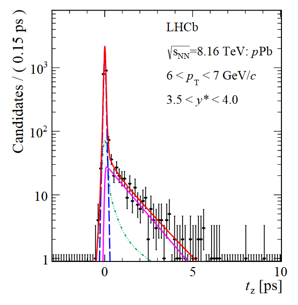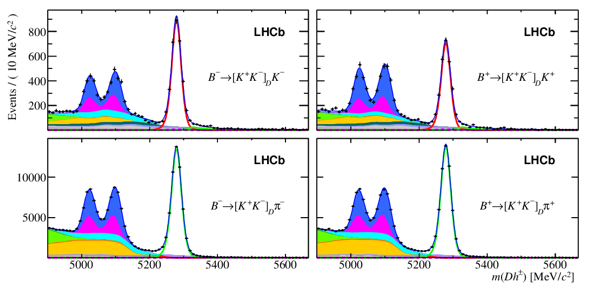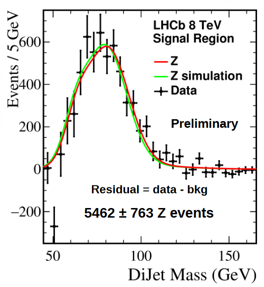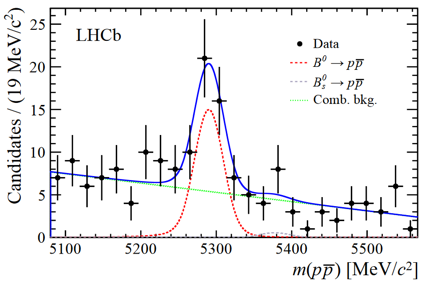The LHCb collaboration presented new results in 32 talks given by LHCb speakers at the EPS Conference on High Energy Physics, EPS-HEP 2017, Venice, Italy. The observation of an exceptionally charming particle, the Ξcc++, was already announced in the 6 July 2017 news. A few other selected items are listed below.
(1) Prompt and nonprompt J/ψ production and nuclear modification in p-Pb collisions at √ sNN = 8.16 TeV. Proton collisions with lead nuclei (p-Pb) at the LHC are very important to understand nuclear effects relevant to the study of quark-gluon plasma formation in lead-lead (Pb-Pb) collisions. The analysis of J/ψ production is of particular interest. Two sets of data were taken: p-Pb and Pb-p, where in the first case the proton travels in the forward direction of LHCb and in the second case the beam directions are reversed. This allowed the LHCb detector, recording the particles only on one side of the interaction point, to make measurements in both forward and backward directions with respect to the proton beam. The LHCb collaboration already obtained results at a collision energy √ sNN = 5 TeV, see e.g. the news on 10 May 2013. New results presented at the EPS-HEP conference are obtained at √ sNN = 8.16 TeV with 10 and 40 times larger data sets in p-Pb and Pb-p collisions, respectively. Both J/ψ mesons produced directly (prompt) and originating from beauty-hadron decays (nonprompt) are studied. A suppression of prompt J/ψ production compared to pp collisions of up to 50% (25%) in p-Pb (Pb-p) at low transverse momentum is observed. For the first time, beauty-hadron production is measured precisely at low momentum at the LHC in p-Pb and Pb-p collisions. In p-Pb, a weak suppression is observed, whereas in Pb-p no significant deviation from unity is found. The LHCb measurements are very important to test and tune different theoretical models of J/ψ production in cold nuclear matter. The image shows how prompt J/ψ (blue dashed line) and J/ψ-from-beauty-hadron (purple solid line) productions are statistically separated in the analysis.
(2) Measurement of CP observables in B± → D(*)0K± and B± → D(*)0π± decays. World’s best measurements of CP observables in B± → D0h± decays are obtained with the D meson reconstructed in the Kπ , KK and ππ final states. Measurements of partially reconstructed B± → D*0h± decays (see the mass distribution in the left image below) are also reported for the first time. Measurements of CP observables in B → (D*0→D0γ)K decays are competitive with the current world averages; the equivalent observables measured in B → (D*0→D0π0)K decays substantially improve upon the existing world averages. Evidence for CP violation in B → (D*0→D0π0)K decays is found with a statistical significance of 4.3 standard deviations. The combination of this results with all other available LHCb measurements of the γ angle of the unitarity triangle, γ = (76.8+5.1-5.7)°, yields quite a significant reduction of the overall uncertainty on this important quantity.
(3) Measurement of the forward Z → bb cross-section in pp collisions at a centre-of-mass energy of 8 TeV. Several extensions of the Standard Model predict that new heavy particles that decay to two energetic b-quarks could be accessible at the energy of LHC collisions. Moreover, the study of the Higgs-boson decay to a pair of b and b quarks at the LHC is of great interest, since the precise determination of the Higgs boson coupling to b-quarks is an important test of the Standard Model. The decay of a Z boson to a bb pair provides a standard candle for direct searches of physics beyond the Standard Model in final states with bb quarks. Measurements of this decay can be used to demonstrate that no biases are induced by the b-jet reconstruction procedure and that the reconstruction efficiencies are evaluated correctly. A clear signal is observed by LHCb for the first time, as shown in the right image above. The product of the cross-section and branching fraction is measured with a precision of about 20%. The theoretical prediction and the measurement are compatible within one standard deviation. Additional data being collected by LHCb will enable a more stringent comparison with the theoretical prediction to be performed. This result opens a new avenue of measurements at LHCb, in a domain typically studied by ATLAS and CMS and where LHCb was not expected initially to give significant results. This is a further example that illustrates that LHCb has become a general purpose forward experiment with a broad physics programme.
(4) Rarest B0 decay ever observed. The B0 meson decay into a pp pair is observed for the first time with a statistical significance of 5.3 standard deviations. The image shows the pp invariant mass spectrum where the contribution of B0→ pp decay is clearly visible. The branching fraction is measured to be (1.25 ± 0.27 ± 0.18)x10-8. This decay is the rarest fully hadronic decay of a B meson ever observed. Studies of B mesons decaying to baryonic final states have been carried out since the late 1990s. It was quickly realized that baryonic B decays differ from mesonic decays since two-body charmless decays are suppressed with respect to decays to multi-body final states. This observation provides a valuable input towards the understanding of the dynamics of hadronic B decays and allows for a better scrutiny of QCD models. In the future, with the analysis of additional data, it is hoped that the Bs0→ pp decay will also be observed.
Please click the images for higher resolution versions. More details on the measurements are given in LHCb EPS-HEP conference presentations, these are linked from the titles of each section (written in italics).




